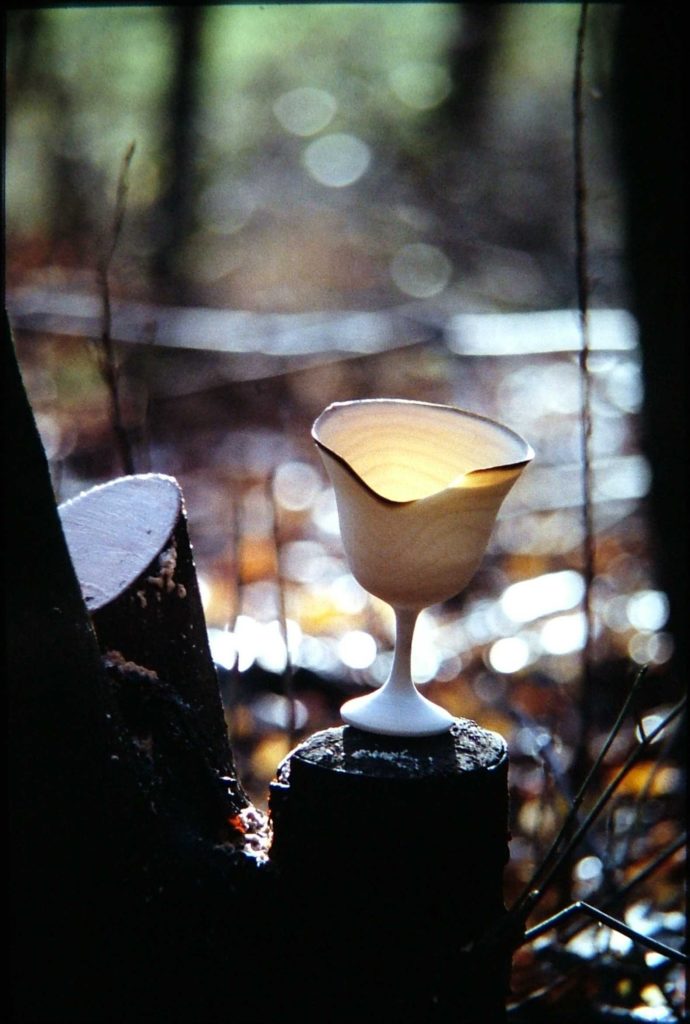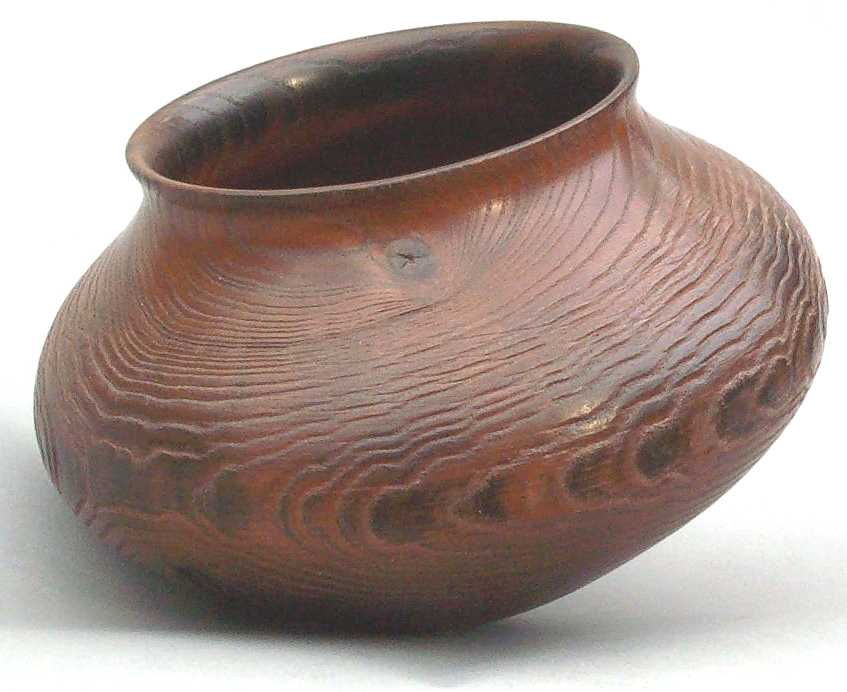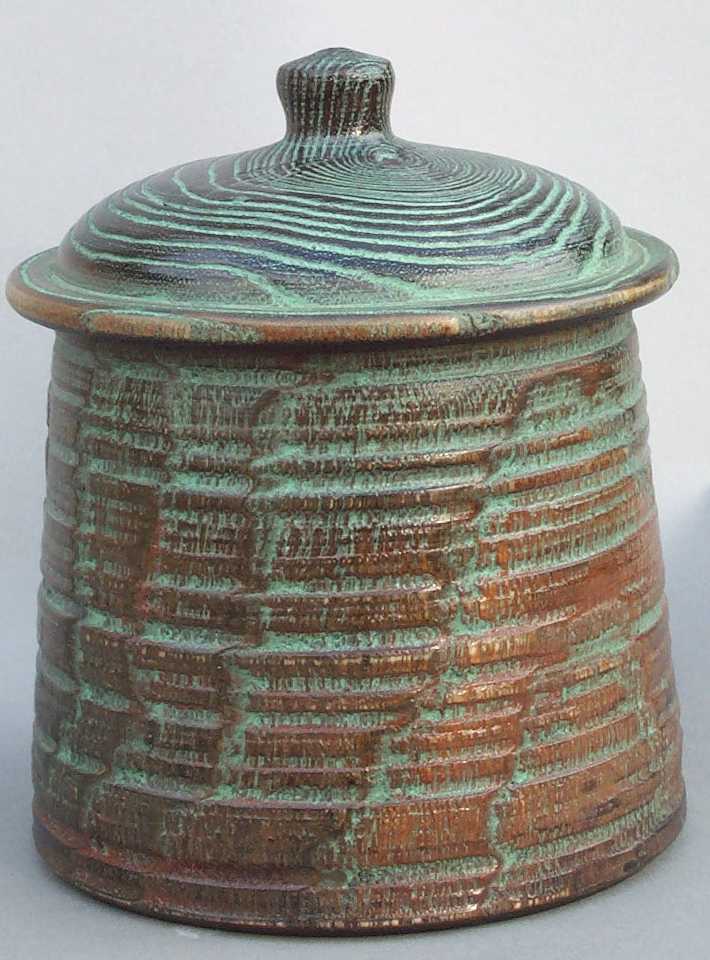The greenwoods of the Chiltern Hills have been a source of inspiration to me
I enjoy them in all seasons and all weathers, I’ve experienced the ever-changing ambiance that misty mornings or shafting sunlight can bring, and that mysterious period just after the sun has set. It’s from these greenwoods I’ve known from childhood that my raw material comes from.
The Chiltern Forests are renowned for their Beech but it’s Sycamore, an interloper of recent centuries, that I use for much of my turned work.
Thin-walled sycamore goblet by Stuart King in the woods, illuminated by sunlight.

Not only is my timber from the greenwood but I also turn it green
Working with ‘wet’ wood is both pleasurable and a challenge. Turning wood wet means there is much less dust and it being softer in it’s unseasoned state, waste removal is easier. There is usually some distortion after a turned piece is dry but to me it is all part of mother natures character and imparts a stamp of individuality, I never make two pieces exactly the same.
The advantages of Sycamore are several: it is easily available, is hard when dry, unlikely to split and takes a good finish. Furthermore it is white to light cream and mostly of plain grain, an ideal ‘canvas’ on which to decorate. Many of my vessels are of traditional form, often reflecting an old English medieval influence that seems to compliment my style of decoration. I have always been aware of a mysterious element that some Forests can generate and it is this that I have been trying to capture in my latest work. The Celtic spirit of the ‘greenwoods’, the ‘Green man’ has become a favorite subject of mine.
Because my vessels are turned quite thin (1- 4mm) the drying period is short, between 5 -14 days at room temperature. When dry, using a soft pencil (a hard one may indent the work) I lightly sketch my ideas onto the surface.
Some of my work is pierced and fretted, this is done as a sequel to the sketching using a ‘mini drill’ fitted with a 3mm milling cutter. It is best not to cut right to the edge of the design, as there is a tendency for the cutter to wander; the edges can be cleaned up using a sharp knife, shaped files and abrasive.
Textured pot in sweet chestnut, by Stuart King. Bronzed and textured, I turned this sweet chestnut bowl from green wood.

Much of my artwork is done using a Peter Child pyrographic pen to burn the image into the wood.
The temperature can be controlled to allow a wide range of shading and effects to be created but some practice is required to overcome the variation between winter and summer growth on end grain. Because summer growth is softer than that of winter the pen has a tendency to burn unevenly and this is an area where care needs to exercised. On some of my early goblets with a wall thickness of 1/2mm or less I used the pen to burn away the piercings. This worked very well but due to the delicate nature of the vessels they were not a commercial proposition, today I turn to a minimum of 1mm, a little more if the piece is to be carved.
Another decorative technique I use is stippling with a drawing pen using black ink.
These drawing pens can be bought at any office supplies shop but one needs to be sure how the ink will react with the final finish. Cellulose or Acrylic spray from a can is my preferred finishing material, and now I always try spraying a sample of wood with a small area of inked work to observe the reaction. I well remember completing a stippled ink face on a goblet only to see it disappear as soon as a cellulose spray was applied. On another occasion the ink turned sepia brown.
Apart from drawing faces and figures, black ink can be used to create silhouette images. Colours are also used on some of my work; these are of two distinct types, spirit stains and paint from aerosol cans. The foot of the Green Man wassail bowl for instance is coloured using both yellow and green spirit stain up to the edge of the pyrography. Because the tree root design is burnt into the wood leaving a small channel a natural barrier is established and provides containment for the stain.
Turned from green English sycamore, this piece by Stuart King is called A Stitch in Time.

These techniques can be used in countless variations restricted only by the imagination. Look around your own environment and sphere of interest for inspiration, you may be surprised!
Lidded pot by Stuart King. Have enjoyed making these lidded pots over the years. I turn them from local ‘green’ wood, then texture and colour them using a variety of methods.

